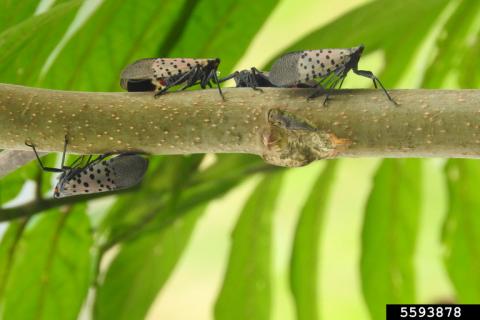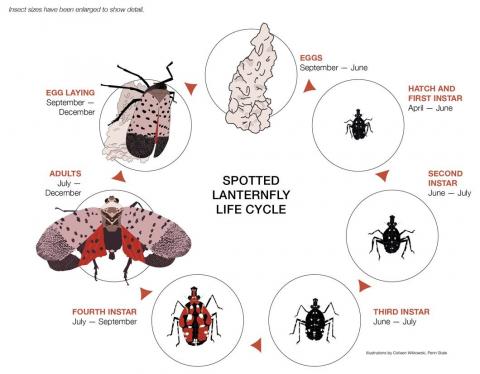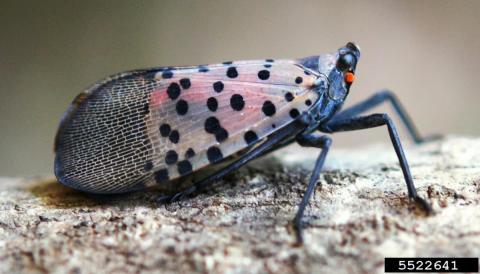The spotted lanternfly (Lycorma delicatula) is a non-native invasive insect with established populations in several northeastern and Midwestern states. It is not known to be established in New Hampshire, but it has been intercepted on nursery stock, landscaping material, and conveyances that have come to the state. Spotted lanternfly kills grapes, stresses hardwood saplings, is bad for businesses, and is a nuisance for residents. Be on the alert and report suspect spotted lanternfly.

Richard Gardner, Bugwood.org
Spotted lanternfly background and risks
It spends its lifetime sucking plant sap from a wide range of host plants, but it prefers Tree of Heaven (Ailanthus altissima). Spotted lanternflies tend to congregate together. This mass feeding causes plant stress and decline. We are still learning about risks to plant health. Grapes are damaged and killed by spotted lanternfly. Feeding on young trees is a stressor for other landscape and ornamental plants, fruit trees, and hardwoods, potentially reducing growth and vigor. Feeding by spotted lanternfly results in build-up of sticky excreta (honeydew) which attracts wasps and other insects and causes black sooty molds. Control of spotted lanternfly increases production costs for nursery stock. Businesses may face increased compliance costs to meet regulatory requirements. Residents are impacted by spotted lanternfly and the associated honeydew, sooty molds, and stinging insects as populations establish and grow.
Resources
Tree of heaven is a preferred host for spotted lanternfly
Tree of Heaven is a prohibited invasive plant in New Hampshire.
Managing Tree of Heaven can reduce spotted lanternfly establishment and distribution by:
- Using it to monitor for spotted lanternfly.
- Treating with insecticides to control spotted lanternfly.
- Treating with herbicides to reduce proliferation of spotted lanternfly.
Report Tree of Heaven sightings to EDDMapS. Reports will be confirmed by the NH Dept. of Agriculture, Markets and Food.
Life Stages
Spotted lanternfly goes through several life stages in a single year. All life stages of spotted lanternfly have distinct appearances and are easily moved. Report suspect spotted lanternflies. Photos can be submitted through this site.
If possible, place the sample in the freezer for verification.














